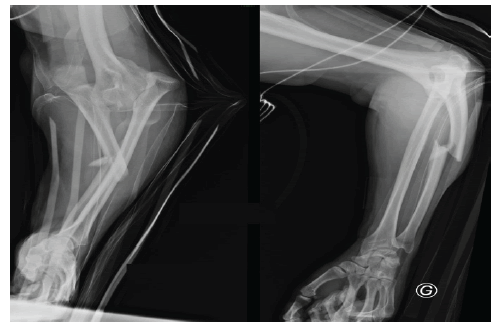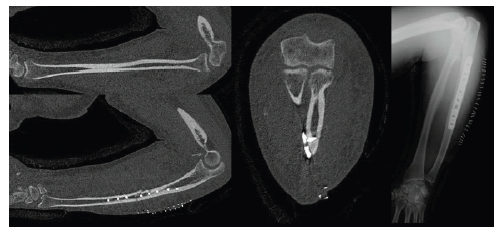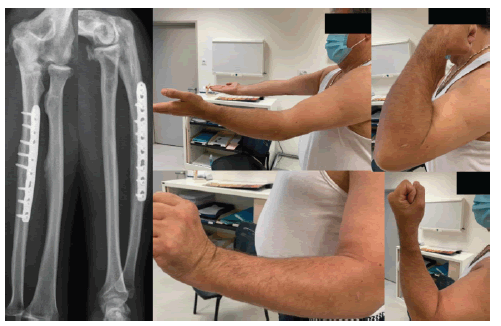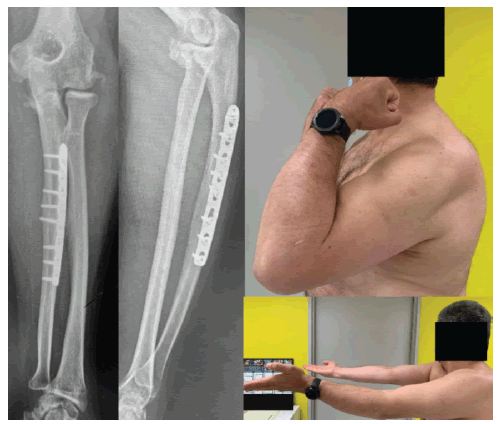An unusual association of elbow divergent dislocation with ulna fracture in an adult
2 Department of Orthopedic Surgery and Trauma, Hospital of Provins, Provins, France
3 Department of Orthopedic Surgery And Trauma, Regional Hospital Center of Orleans, Orleans, France
Received: 06-Dec-2022, Manuscript No. jotsrr-22- 82540; Editor assigned: 07-Dec-2022, Pre QC No. jotsrr-22- 82540(PQ); Accepted Date: Dec 30, 2022 ; Reviewed: 21-Dec-2022 QC No. jotsrr-22- 82540(Q); Revised: 28-Dec-2022, Manuscript No. jotsrr-22- 82540(R); Published: 02-Jan-2023, DOI: 10.37532/1897- 2276.2022.17(12).72
This open-access article is distributed under the terms of the Creative Commons Attribution Non-Commercial License (CC BY-NC) (http://creativecommons.org/licenses/by-nc/4.0/), which permits reuse, distribution and reproduction of the article, provided that the original work is properly cited and the reuse is restricted to noncommercial purposes. For commercial reuse, contact reprints@pulsus.com
Abstract
Traumatic divergent dislocation of the elbow is an extremely rare injury that usually occurs in children. Warmont gave the clinical descriptions of the first cases in 1854 and Wight in 1893. Delee reported the first radiologically confirmed case in1981, and since then, 13 cases have been reported among young patients and only 5 in adults. Here, we present the unusual association of a divergent dislocation of the left elbow with a fracture of the ulna shaft in a 55-year-old man. After a successful reduction of the dislocation, internal fixation of the ulna shaft was done and the arm was casted for three weeks followed by early mobilization. At one-year follow-up, the patient regained full range of motion. The treatment of divergent dislocation of the elbow in adult is guided by some cases reported in the literature and until now, there is no clear consensus. In this unusual case, the surgery was necessary and fortunately led us to a good clinical outcome. Finally, our case can be added to the previous one hoping for a better understanding of this pathology.
Keywords
Dislocation, divergent, elbow, ulna, adult
Introduction
Traumatic divergent dislocation of the elbow, in which the radius and ulna dislocate in diverging directions, remains an infrequent injury that usually occurs in children. The mechanism of this injury remains misunderstood nonetheless clearly due to high-energy trauma. The first case of a divergent dislocation of elbow in adults was reported in 2003 by Moritomo et al. [1].
T he other cases described the same dislocation but associated with different lesions which explain the lack of information vis-à-vis this injury and the absence of a concrete treatment protocol. In children, closed reduction with cast immobilization is the method of treatment recommended. However, in adults, the degree of soft-tissue injuries and the associated fracture makes the treatment much more complicated. We can conclude from all reported cases that surgery must be undertaken in case of elbow instability. Here we present the case of a 55 year-old man with a traumatic divergent dislocation of the elbow combined with ipsilateral fracture of the ulna shaft. [2-5].
Case Report
A 55-year-old man was admitted to our department for a closed trauma of the left elbow caused by falling from a height of 3 meters. An initial examination found pain, swelling, and deformation of the elbow with the forearm fully pronated, which appeared to be shortened. Examination of the ipsilateral shoulder and wrist was pain-free and neurovascular injuries were not apparent. The preliminary evaluation allowed us to suspect a traumatic elbow dislocation. The anteroposterior radiograph showed a lateral dislocation of the radial head, dislocated both at the elbow and the superior radio-ulnar joint, a medial dislocation of the ulna and a wedge fracture of the ulnar shaft. The lateral view showed a posterior dislocation of both ulna and radial head. The radiograph of the distal radioulnar joint was normal (Figure 1).
The association of this dislocation with fracture of the shaft of the radius in an adult has not been described. The surgery was done on the same day. Due to the extensive injury (proximal interosseous membrane, proximal radio-ulnar articulation ligaments, lateral collateral ligament complex, medial collateral ligament complex and the capsule), the reduction of the dislocation was easy to achieve, and then a locking compression plate was applied to perform an open reduction and internal fixation of the ulna shaft through a posterior approach. Postoperative radiographs and CT-scan showed a good reduction of the elbow, the superior radioulnar joints, and the ulna shaft (Figure 2).
The elbow joint was unstable when extended to less than 50°, because of the medial and lateral collateral ligament complex injury, but we were able to maintain a perfect reduction using so a long arm cast with an elbow in full pronation and 90oc flexion for three weeks. After that, early mobilization was begun to avoid stiffness. The fracture was healed within 14 weeks. At 6 months, we obtained 130°/30°/0° with a DASH 6 at 14.2 out of 100 (Figure 3).
At 12 months, the elbow range of motion reached 140°/20°/0° with a clear improvement of DASH score (DASH 12 at 6,5 out of 100) (Figure 4).
The patient was very happy with the results and was able to return to their job and daily activities.
Discussion
Traumatic divergent dislocation of the elbow remains a rare type of elbow dislocation. The proximal radius and ulna are both dislocated in diverging directions. Warmont gave the clinical descriptions of the first cases in 1854 and Wight in 1893 [6-7]. Later, Delee reported the first radiologically confirmed case in 1981 and since then, thirteen cases have been reported among young patients (11 children and 2 boys) and only 5 in adults: Moritomo et al. reported a divergent dislocation in adults, but as an unusual complication of SauveKapandji. Kazuki, Laratta, Casstevens and Greene described a traumatic divergent of the elbow combined with different lesions [8, 9]. We believe that our case is the first report of a traumatic divergent dislocation of the elbow combined with a fracture of the ulnar shaft. The mechanism of this type of dislocation is poorly understood and usually due to high-energy trauma with extensive soft tissue disruption [2]. The trochlea is first displaced anteriorly, disrupting the annular ligament from its ulnar attachment and drives between the proximal radius and ulna, causing a disruption of the interosseous ligament and a divergence of proximal radius and ulna. This effect forces the ulna to rotate into valgus and dislocate in the posteromedial direction, and the pronation of the forearm causes posterolateral dislocation of the radial head. The soft tissue lesions depend on the degree of displacement. Others suggest that the injury occurs after an axial load with a hyper pronation force [2, 9, 10]. In our case, the mechanism remains unknown, and judging from the lesions: we supposed that the injury followed an axial loading with an extended elbow and a pronated or hyper pronated forearm. The literature on the treatment of this injury is limited to guide the surgeon. Most authors [2-5] reported a quickly closed reduction but challenging to maintain since few stabilizing soft tissue elements are left intact. In our case, surgery was required because of ipsilateral forearm injuries and elbow instability, then we choose an immobilization with a long arm cast for its simplicity, efficiency, facility of supervising and removal. It maintained elbow reduction, allowed soft tissue healing and it needs to be limited to three or four weeks and need to be followed by early mobilization to avoid stiffness [11]. In all cases reported in the literature [2-5], the surgery and the early mobilization was necessary however the type of immobilization was different. Kazuki, Casstevens and Greene opted for an immobilization with a long arm cast for 3 and 4 weeks, Laratta applied an external fixation for 2 weeks nevertheless all of them obtained a good final result, so both external fixation and cast immobilization can be used in the management of divergent elbow dislocation as long as a good reduction is accomplished and an early mobilization is done. Given the final result, our management was good enough to ensure a good clinical outcome without any complications and can be added to the previous one for a better understanding of this pathology.
Conclusion
In adults, complete dislocation of all three articulations, humeroulnar, radio-capitellar, and radio-ulnar remains an uncommon injury, especially when another lesion is combined. The literature is limited to some case reports guiding the surgeon on the therapeutic management. From our experience and all the previous cases reported in the literature, the main objective is to restore the stability of the elbow and forearm. So, surgery is constantly necessary in adult to achieve a good reduction that can be maintained with a long arm cast or an external fixation for 3 weeks or 4 weeks, then early mobilization needs to be started early to avoid stiffness and to achieve good results.
References
- Moritomo H, Izawa K, Murase T, et al. Spontaneous divergent elbow dislocation after Sauve-Kapandji procedure. Clin Orthop Relat Res. 2003, 406:97-102. [Google Scholar] [CrossRef]
- Kazuki K, Miyamoto T, Ohzono K. A case of traumatic divergent fracture-dislocation of the elbow combined with Essex-Lopresti lesion in an adult. J Shoulder Elbow Surg 2005, 14:224-6. [Google Scholar] [CrossRef]
- Laratta JL, Yoon RS, Frank MA, et al. Divergent elbow dislocation with radial shaft fracture, distal ulnar deformation, and distal radioulnar joint instability: an unclassifiable Monteggia variant. J Orthop Traumatol 2014, 15:63-7. [Google Scholar] [CrossRef]
- Casstevens EC, Calfee RP, Sterne PJ. Traumatic divergent elbow dislocation in an adult with an associated fracture of the distal part of the humeral shaft and an open perilunate dislocation. JBJS Case Connector. 2017, 2:61. [Google Scholar] [CrossRef]
- Greene RM, Bader JE, Mauter L, et al. Traumatic Divergent Elbow Dislocation with Associated Forearm Amputation in an Adult: A Case Report. JBJS Case Connect. 2018, 8:92-5. [Google Scholar] [CrossRef]
- Mansuripur PK, Deren ME, Lareau CR,. Divergent elbow dislocation and risk of compartment syndrome. Rhode Island Medical Journal. 2015 May 1;98(5):25. [GoogleScholar] [CrossRef]
- Hyman G, Martin FR. Dislocation of the inferior radio‐ulnar joint as a complication of fracture of the radius. British Journal of Surgery. 1940 Jan;27(107):481-91. [Google Scholar] [CrossRef]
- DeLee JC. Transverse divergent dislocation of the elbow in a child. A case report. J Bone Joint Surg. 1981; 63A: 322-3[Google Scholar] [CrossRef]
- Van Wagenberg JM, van Huijstee PJ, Verhofstad MH. Pediatric complex divergent elbow dislocation. J Orthopaedic trauma. 2011, 25:5-8. [Google Scholar] [CrossRef]
- Zaricznyj B. Transverse divergent dislocation of the elbow. Clin Orthop. 2000, 373:146-52. [Google Scholar] [CrossRef]
- Altuntas AO, Balakumar J, Howells RJ, et al. Posterior divergent dislocation of the elbow in children and adolescents: a report of three cases and review of the literature. J Pediatr Orthop. 2005, 25:317–21. [Google Scholar] [CrossRef]







 Journal of Orthopaedics Trauma Surgery and Related Research a publication of Polish Society, is a peer-reviewed online journal with quaterly print on demand compilation of issues published.
Journal of Orthopaedics Trauma Surgery and Related Research a publication of Polish Society, is a peer-reviewed online journal with quaterly print on demand compilation of issues published.